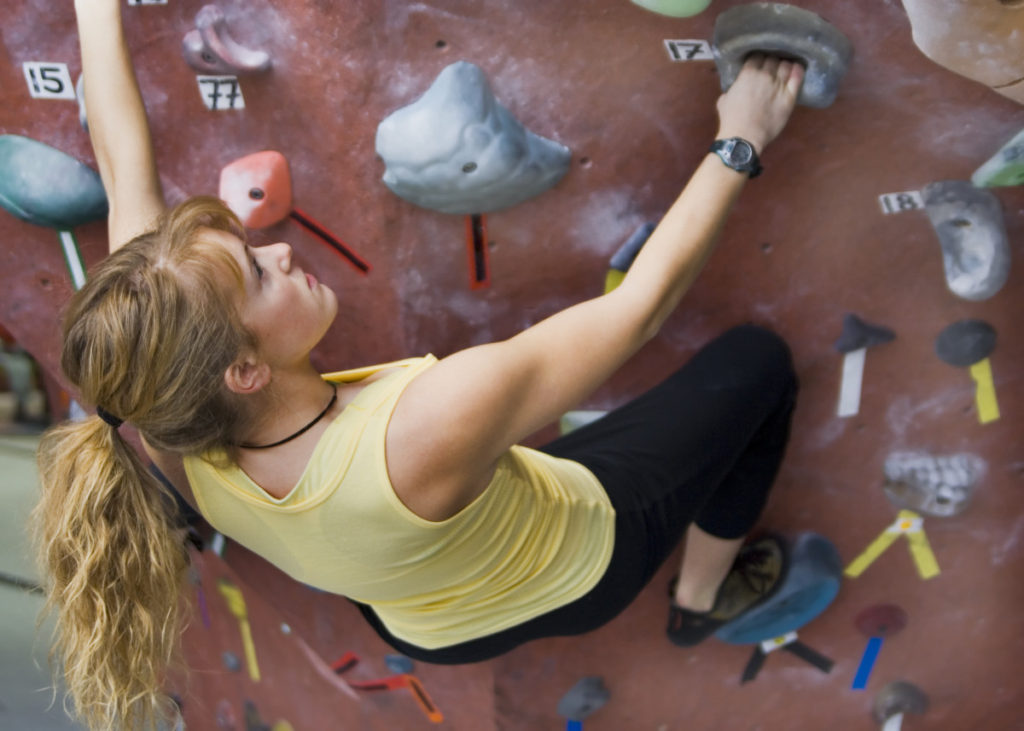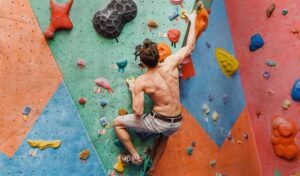A boulder problem in rock climbing refers to a particular section of a rock that is challenging to climb without the use of ropes and harnesses. These problems are often measured by difficulty using the v-scale, ranging from v0 (easiest) to v17 (most difficult).
Boulder problems require a combination of strength, technique, and problem-solving skills to navigate successfully. Rock climbing is a popular outdoor sport that has gained significant traction in recent years. Climbing enthusiasts seek out natural rock formations and artificial climbing walls to test their skills and push themselves to new heights.
One of the most exciting aspects of rock climbing is the boulder problem. In this guide, we’ll break down what a boulder problem is, how to tackle them, and their difficulty ratings. So, whether you’re a beginner or a seasoned pro, read on to learn more about boulder problems in rock climbing.

Credit: boulderingboss.com
Understanding The Basics Of A Boulder Problem
Defining A Boulder Problem In Rock Climbing
Bouldering is a type of rock climbing that involves climbing on small rock formations, known as boulders. In this sport, the climbers only ascend a short distance to reach the top of the boulder. A boulder problem is a challenging climbing sequence that must be completed to successfully climb to the top of a boulder.
It is often characterized by difficult moves or unique physical challenges. The following are the different types of boulder problems that climbers may encounter.
Exploring The Different Types Of Boulder Problems
There are various types of boulder problems, and each requires unique physical and mental approaches. Here are the most common types of boulder problems:
- Dynamic movements:
In this type of boulder problem, the climber must use quick and explosive movements to reach their next hold. It usually involves jumping or lunging from one hold to another.
- Technical sequences:
This type of boulder problem requires precise footwork and body positioning rather than pure power. Climbers must plan each move before attempting to climb the problem.
- Endurance routes:
Endurance boulder problems require the climber to complete a sustained series of moves without breaks. This category puts the climber’s overall strength and endurance to the test.
Dynamic Movements
Dynamic movements are some of the most exciting types of boulder problems in climbing. Unlike technical sequences that demand precise footwork, dynamic movements emphasize explosive and quick movements. Here are some types of dynamic movements in bouldering:
- Jumping:
Jumping from one hold to another requires timing, precision, and a powerful lower body. Climbers use their legs to propel them from one handhold to another, making them airborne for a brief moment.
- Lunging:
Lunging involves stretching out for the next hold using momentum and upper body strength. It requires the climber to land on the hold with their hands and feet simultaneously.
- Dynos:
Dynos, short for ‘dynamic moves,’ require the climber to throw themselves upwards from a low position to reach a higher hold. It requires the right combination of power, timing, and precision.
Technical Sequences
Technical sequences exhibit the climbers’ precision and focus by requiring them to execute a sequence of movement with precision and control. Climbers need to understand their strengths and body positioning with this type of boulder problem. Below are some examples of technical sequences:
- Balancing:
Balancing is a technical skill that requires the climber to shift their weight appropriately for each move. It requires a great deal of core strength and precise body positioning.
- Crims:
A crim is a small and challenging hold that requires climbers to use their fingers’ tips instead of the palm to hang onto the rock. Crimpy moves demand a great deal of finger strength and careful foot placement.
- Smearing:
Smearing is a technique used when there are no visible holds. Instead, climbers use their rubber soles and friction to hold themselves up against the rock.
Endurance Routes
Endurance routes are usually long and demanding and require the climber to hold on for an extended period. Endurance bouldering can be challenging since the climber needs to have longer stamina to hold the grips for an extended period of time.
Here are some examples of endurance boulder problems:
- Circuit training:
Circuit training involves trying multiple boulder problems, one after another, without rest. It requires overall power endurance and good time management skills.
- Pumpy climb:
Pumpy climbs are boulder problems that require the climber to hold on to powerful, but not impossible, moves that gradually wear them out. It requires climbers to conserve their power and plan how to complete the route.
- Linking moves:
Linking moves is when a climber combines several hard moves into a longer sequence. This requires physical and mental endurance, as they must climb without rest and pace themselves.
Overall, there are quite a few different types of boulder problems in rock climbing. People choose this sport because it gives them an adrenaline rush and a rush of endorphins that comes from the sense of accomplishment after completing a boulder problem.
If you’re looking to get started with bouldering, then it is important to first get familiar with the types of boulder problems and then start working on your skills to overcome them!
Mastering Boulder Problems: Tips And Tricks
Rock climbing can be an intense physical and mental challenge, with various obstacles that a climber must overcome to reach their goal. Boulder problems are no exception. Boulder problems entail shorter climbs without gear where the focus is on movement, strength, and technique.
Here are some essential tips and tricks to help you master boulder problems:
Mental Preparation And Visualization Techniques
Preparing your mental state can be just as important as physical preparation. Visualization techniques can help prepare your mind for challenges that may arise. Here are a few tips to enhance your mental game:
- Clear your mind before starting a climb.
- Visualize the climb before starting.
- Focus on one move at a time.
- Use positive self-talk throughout the climb.
Physical Training Approaches For Climbing Boulder Problems
Rock climbing mainly depends on the physical limits of the climber, and this is especially true when it comes to boulder problems. Physical training approaches include:
Strength Training
Building strength is essential for overcoming tough boulder problems. Incorporate exercises that focus on your upper body and core, such as:
- Pull-ups
- Push-ups
- Plank variations
- Deadlifts
Endurance Training
While strength is vital, endurance is equally necessary. Work in exercises that target your endurance like these:
- Running
- Swimming
- Circuit training
- Climbing routes for extended periods
Flexibility And Mobility
Flexibility and mobility support good form, technique, and endurance, which is essential in conquering boulder problems. Incorporating these exercises will help you improve your flexibility and mobility:
- Yoga
- Dynamic stretching
- Pnf stretching
- Foam roller
Climbing Techniques For Tackling Boulder Problems
Climbing techniques and strategies play a critical role in tackling boulder problems. Here are a few techniques to improve your climbing:
Reading The Route
Reading the route is just as important for boulder problems as it is for other types of climbing. It’s about finding the right sequence and adapting your movements accordingly. Consider these tips for reading the route:
- Study the route before beginning the climb.
- Identify any challenges, sequences, and handholds marked on the route.
- Plan an initial sequence.
- Redefine the sequence mid-climb if necessary.
Proper Body Positioning
Proper body positioning is essential to both climbing efficiently and injury prevention. Here are some proper body positioning techniques:
- Center your weight over your feet.
- Keep your hips close to the wall.
- Use your feet whenever possible.
Efficient Movement
Efficient movement is essential in boulder problems. It is about conserving energy by eliminating inefficient movements. Here are some essential tips:
- Move in a straight line unless the holds force you to move laterally.
- Avoid excessive swinging.
- Push with your feet instead of pulling with your arms.
By understanding these techniques and developing these skills, you can improve your climbing capacity, tackle more complex boulder problems and enjoy a more fulfilling climbing experience.
Frequently Asked Questions On What Is A Boulder Problem In Rock Climbing?
What Is A Boulder Problem In Rock Climbing?
A puzzle-like sequence of moves on a boulder using only hands and feet, without ropes.
What Are The Different Types Of Boulder Problems?
Slab, vertical, overhang and roof are the four categories of types of boulder problems.
What Are Some Techniques For Solving A Boulder Problem?
Reading the problem, proper footwork, and hand placement, body positioning, and proper breathing.
Conclusion
After reading this article, you now understand that rock climbing involves various techniques to overcome obstacles. Boulder problems are one of the most popular and challenging obstacles a climber can face. Boulder problems test a climber’s strength, technique, flexibility, balance, and creativity.
It requires a combination of physical and mental skills to solve them. Whether you are a beginner or an experienced climber, knowing how to tackle a boulder problem is essential. Understanding the different types of holds, evaluating the route, and trying different approaches are some of the critical factors to consider.
Overall, rock climbing is an incredibly challenging and rewarding sport that requires passion, patience, and perseverance. Boulder problems provide a unique opportunity for climbers to challenge themselves and push their limits. So get out there, challenge yourself, and have fun!



